Improving the Usage Properties of Steel Using Cold Spray Deposition: A Review
Abstract
:1. Introduction
2. Studies Using the Cold Spray Method
2.1. Types of Materials Used for Cold Spray
2.2. Cold Spray Method
3. Properties Obtained by the Cold Spray Method
3.1. Microstructural Properties of Coatings by the Cold Spray Method
3.2. Mechanical Properties of the Coatings of the Cold Spray Method
3.3. Corrosion Resistance Properties of Coatings by the Cold Spray Method
3.4. Potential Applications Using the Cold Spray Method
4. Discussion
5. Conclusions
Author Contributions
Funding
Data Availability Statement
Conflicts of Interest
References
- Cristea, S. Contributii la Studiul Comportarii Unor Materiale de Blindaj la Impactul cu Proiectilul. Ph.D. Thesis, Lucian Blaga University, Sibiu, Romania, 2008. [Google Scholar]
- Phillips Federal News. Available online: https://phillipscorp.com/federal/2020/06/24/vrc-army-phillips-federal/ (accessed on 6 September 2022).
- Shikalov, V.S.; Vidyuk, T.M.; Filippov, A.A.; Kuchumova, I.D. Microstructure, mechanical and tribological properties of cold sprayed Cu-W coatings. Int. J. Refract. Met. Hard Mater. 2022, 106, 105866. [Google Scholar] [CrossRef]
- Wei, F.J.; Chou, B.Y.; Fung, K.Z.; Tsai, S.Y. Thermomechanical properties of cold-sprayed copper coatings from differently fabricated powders. Surf. Coat. Technol. 2022, 434, 128128. [Google Scholar] [CrossRef]
- Ranjan, R.; Das, A.K. A review on surface protective coating using cold spray cladding technique. Mater. Today Proc. 2022, 56, 768–773. [Google Scholar] [CrossRef]
- Poza, P.; Maneiro, M.A.G. Cold-sprayed coatings: Microstructure, mechanical properties and wear behaviour. Prog. Mater. Sci. 2022, 123, 100839. [Google Scholar] [CrossRef]
- Champagne, V.K. The Cold Spray Materials Deposition Process: Fundamentals and Applications; Woodhead: Cambridge, UK, 2007; p. 376. [Google Scholar]
- Neu, R.; Maier, H.; Boswirth, B.; Elgeti, S.; Greuner, H.; Hunger, K.; Kondas, J.; Muller, A. Investigations on cold spray tungsten/tantalum coatings for plasma facing applications. Nucl. Mater. Energy 2022, 34, 101343. [Google Scholar] [CrossRef]
- Jan, C.; Monika, V.; Frantisek, L.; Martin, K.; Jan, K.; Reeti, R.S. Cold Sprayed Tungsten Armor for Tokamak First Wall. Coatings 2019, 9, 836. [Google Scholar]
- Yeom, H.; Sridharan, K. Cold spray technology in nuclear energy applications: A review of recent advances. Ann. Nucl. Energy 2021, 150, 107835. [Google Scholar] [CrossRef]
- SSAB. Available online: https://www.ssab.com/en (accessed on 7 September 2022).
- Dwight, D.S.; William, A.G.; Mattew, S.B.; Stockman, R.K. Balistic Testing of SSAB Ultra-High-Hardness Stell for Armour Applications; Army Research Laboratory: Adelphi, MD, USA, 2008. [Google Scholar]
- Olimpicsteel. Available online: https://www.olysteel.com/products/alloy/mil-dtl-46100-mil-a-46100-armor-steel (accessed on 7 September 2022).
- Poplawski, A.; Kedzierski, P.; Mork, A. Identification of Armox 500T steel failure properties in the modeling of perforation problems. Mater. Des. 2020, 190, 108536. [Google Scholar] [CrossRef]
- Alloy Steel 52100. Available online: https://continentalsteel.com/carbon-steel/grades/alloy-52100/ (accessed on 21 September 2022).
- Panda, A.; Sahoo, A.K.; Kumar, R.; Das, R.K. A review on machinability aspects for AISI 52100 bearing steel. Mater. Today Proc. 2020, 23, 617–621. [Google Scholar] [CrossRef]
- Kiranbabu, S.; Tung, P.Y.; Sreekala, L.; Prithiv, T.S.; Hickel, T.; Pippan, R.; Morsdorf, L.; Herbig, M. Cementite decomposition in 100Cr6 bearing steel during high-pressure torsion: Influence of precipitate composition, size, morphology and matrix hardness. Mater. Sci. Eng. A 2022, 833, 142372. [Google Scholar] [CrossRef]
- Qin, Y.; Mayweg, D.; Tung, P.Y.; Pippan, R.H. Mechanism of cementite decomposition in 100Cr6 bearing steels during high pressure torsion. Acta Mater. 2020, 201, 79–93. [Google Scholar] [CrossRef]
- Rahbar-Kelishami, A.; Abdollah-Zadeh, A.; Hadavi, M.M.; Benerji, A.; Alpas, A.; Gerlich, A.P. Effects of friction stir processing on wear properties of WC-12%Co sprayed on 52100 steel. Mater. Des. 2015, 86, 98–104. [Google Scholar] [CrossRef]
- Agiwal, H.; Yeom, H.; Pocquette, N.; Sridharan, K.; Pfefferkorn, F.E. Friction surfacing and cold spray deposition for surface crack repair in austenitic stainless steels. Mater. Today Comun. 2022, 33, 104692. [Google Scholar] [CrossRef]
- Yeom, H.; Dabney, T.; Pocquette, N.; Ross, K.; Pfefferkorn, F.E.; Sridharan, K. Cold spray deposition of 304L stainless steel to mitigate chloride-induced stress corrosion cracking in canisters for used nuclear fuel storage. J. Nucl. Mater. 2020, 538, 152254. [Google Scholar] [CrossRef]
- Wan, W.; Li, W.; Wu, D.; Qi, Z.; Zhang, Z. New insights into the effects of powder injector inner diameter and overhang length on particle accelerating behavior in cold spray additive manufacturing by numerical simulation. Surf. Coat. Technol. 2022, 444, 128670. [Google Scholar] [CrossRef]
- Lupoi, R.; Neill, W. Powder stream characteristics in cold spray nozzles. Surf. Coat. Technol. 2011, 206, 1069–1076. [Google Scholar] [CrossRef] [Green Version]
- Singh, H.; Sidhu, T.S.; Kalsi, S.B.S. Cold spray technology: Future of coating deposition processes. Frat. Integrità Strutt. 2012, 22, 69–84. [Google Scholar] [CrossRef] [Green Version]
- Wong, W.; Rezaeian, A.; Irissou, E.; Legoux, J.G.; Yue, S. Cold spray characteristics of commercially pure Ti and Ti-6Al-4V. Adv. Mater. Res. 2010, 89–91, 639–644. [Google Scholar]
- Herrera, J.E.J.; Bousser, E.; Schmitt, T.; Klemberg, S.J.E.; Martinu, L. Effect of plasma interface treatment on the microstructure, residual stress profile, and mechanical properties of PVD TiN coatings on Ti-6Al-4V substrates. Surf. Coat. Technol. 2021, 413, 127058. [Google Scholar] [CrossRef]
- Jun, Y.L.; Ayan, B.; Adrian, W.Y.T.; Wen, S.; Xu, S.; Wei, Z.; Pio, J.B.; Feng, L.; Rjia, L.; Teng, M.L.; et al. Understanding the microstructural evolution of cold sprayed Ti-6Al-4V coatings on Ti-6Al-4V substrates. Appl. Surf. Sci. 2018, 459, 492–504. [Google Scholar]
- Goanta, V.; Munteanu, C.; Muftu, S.; Istrate, B.; Schwartz, P.; Boese, S.; Ferguson, G.; Moraras, C.I.; Stefan, A. Evaluation of the Fatigue Behavior and Failure Mechanisms of 4340 Steel Coated with WIP-C1 (Ni/CrC) by Cold Spray. Materials 2022, 15, 8116. [Google Scholar] [CrossRef] [PubMed]
- Goanta, V.; Munteanu, C.; Muftu, S.; Istrate, B.; Schwartz, P.; Boese, S.; Ferguson, G.; Moraras, C.I. Evaluation of the Fatigue Behavior and Failure Mechanisms of 52100 Steel Coated with WIP-C1 (Ni/CrC) by Cold Spray. Materials 2022, 15, 3609. [Google Scholar] [CrossRef] [PubMed]
- Lioma, D.; Sacks, N.; Botef, I. Cold gas dynamic spraying of WC-Ni cemented carbide coating. Int. J. Refract. Met. Hard Mater. 2015, 49, 365–373. [Google Scholar] [CrossRef]
- Melendez, N.M.; Narulkar, V.V.; Fisher, G.A.; McDonald, A.G. Effect of reinforcing particles on the wear rate of low-pressure cold-sprayed WC-based MMC coatings. Wear 2013, 306, 185–195. [Google Scholar] [CrossRef]
- Silva, F.C.; Cinca, N.; Dosta, S.; Cano, I.G.; Couto, M.; Guilemany, J.M.; Benedetti, A.V. Corrosion behaviour of WC-Co coatings deposited by cold gas spray onto AA 7075-T6. Corros. Sci. 2018, 136, 231–243. [Google Scholar] [CrossRef] [Green Version]
- Couto, M.; Dosta, S.; Torrell, M.; Fernandez, J.; Guilemany, J.M. Cold spray deposition of WC-17 and 12Co cermets onto aluminium. Surf. Coat. Technol. 2013, 235, 54–61. [Google Scholar] [CrossRef]
- Ashokkumar, M.; Thirumalaikumarasamy, D.; Thirumal, P.B. Influences of Mechanical, Corrosion, erosion and tribological performance of cold sprayed Coatings A review. Mater. Today Proc. 2021, 46, 7581–7587. [Google Scholar] [CrossRef]
- Zhu, L.; Xu, B.; Zhou, M.; Hu, S.; Zhang, G. Fabrication and characterization of Al-Zn-Cu composite coatings with different Cu contents by cold spraying. Surf. Eng. 2020, 36, 1090–1096. [Google Scholar] [CrossRef]
- Zhang, Z.; Liu, F.; Han, E.H.; Xu, L. Mechanical and corrosion properties in 3.5% NaCl solution of cold sprayed Al-based coatings. Surf. Coat. Technol. 2020, 385, 12537. [Google Scholar] [CrossRef]
- Ma, J.; Wen, J.; Li, Q.; Zhang, Q. Electrochemical polarization and corrosion behavior of Al-Zn-In based alloy in acidity and alkalinity solutions. Int. J. Hydrog. Energy 2013, 38, 14896–14902. [Google Scholar] [CrossRef]
- Mohammed, A.A. A newly synthesized glycine derivative to control uniform and pitting corrosion processes of Al induced by SCN-anions-Chemical, electrochemical and morphological studies. Corros. Sci. 2010, 52, 3243–3257. [Google Scholar]
- Kumar, S.; Kumar, M.; Jindal, N. Overview of cold spray coating application comparisons: A critical review. World J. Eng. 2020, 17, 27–51. [Google Scholar] [CrossRef]
- Pathak, S.; Saha, G. Development of Sustainable Cold Spray Coatings and 3D Additive Manufacturing Components for Repair/Manufacturing Applications: A Critical Review. Coatings 2017, 7, 122. [Google Scholar] [CrossRef] [Green Version]
- Gadow, R.; Killinger, A.; Stiegler, N. Hidroxyapatite coatings for biomedical applications deposited by different thermal spray techniques. Surf. Coat. Technol. 2010, 205, 1157–1164. [Google Scholar] [CrossRef]
- Zou, Y.; Qiu, Z.; Huang, C.; Zeng, D.; Lupoi, R.; Zhang, N.; Yin, S. Microstructure and tribological properties of Al2O3 reinforced FeCoNiCrMn high entropy alloy composite coatings by cold spray. Surf. Coat. Technol. 2022, 434, 128205. [Google Scholar] [CrossRef]
- Available online: https://jteg.ncms.org/wp-content/uploads/2019/09/02-Aaron-JTEG-CS-4-28-2020.pdf (accessed on 14 September 2022).
- Che, H.; Liberati, A.C.; Chu, X.; Chein, M.; Nobari, A.; Vo, P.; Yue, S. Metallization of polymers by cold spraying with low melting point powders. Surf. Coat. Technol. 2021, 418, 127229. [Google Scholar] [CrossRef]
- Che, H.; Phuong, V.; Stephen, Y. Investigation of cold spray on polymers by single particle impact experiments. J. Therm. Spray Technol. 2019, 28, 135–143. [Google Scholar] [CrossRef] [Green Version]
- Che, H.; Chu, X.; Vo, P.; Yue, S. Metallization of various polymers by cold spray. J. Therm. Spray Technol. 2018, 27, 169–178. [Google Scholar] [CrossRef] [Green Version]
- Chen, M.; Che, H.; Yue, S. Exploring surface preparation for cold spraying on polymers. Surf. Coat. Technol. 2022, 450, 128993. [Google Scholar] [CrossRef]



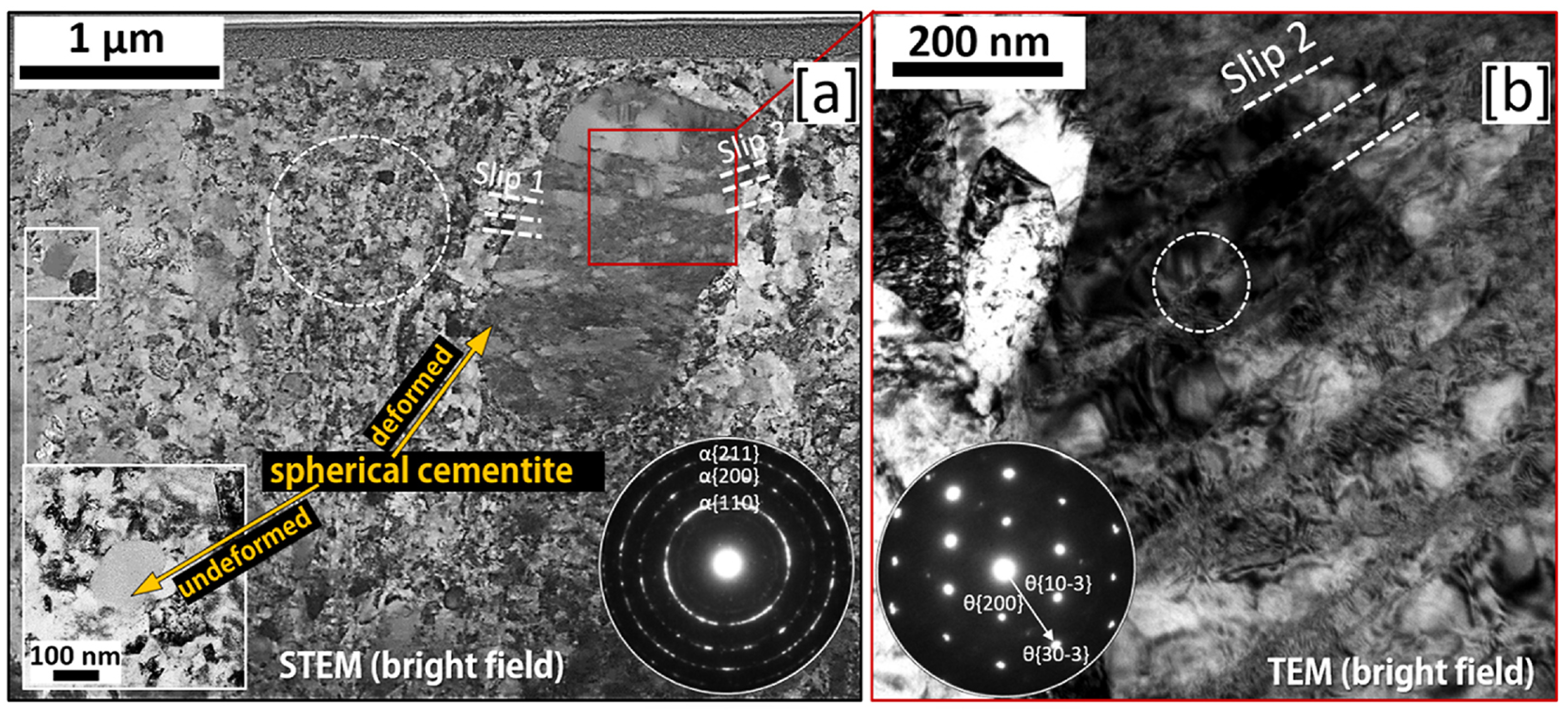
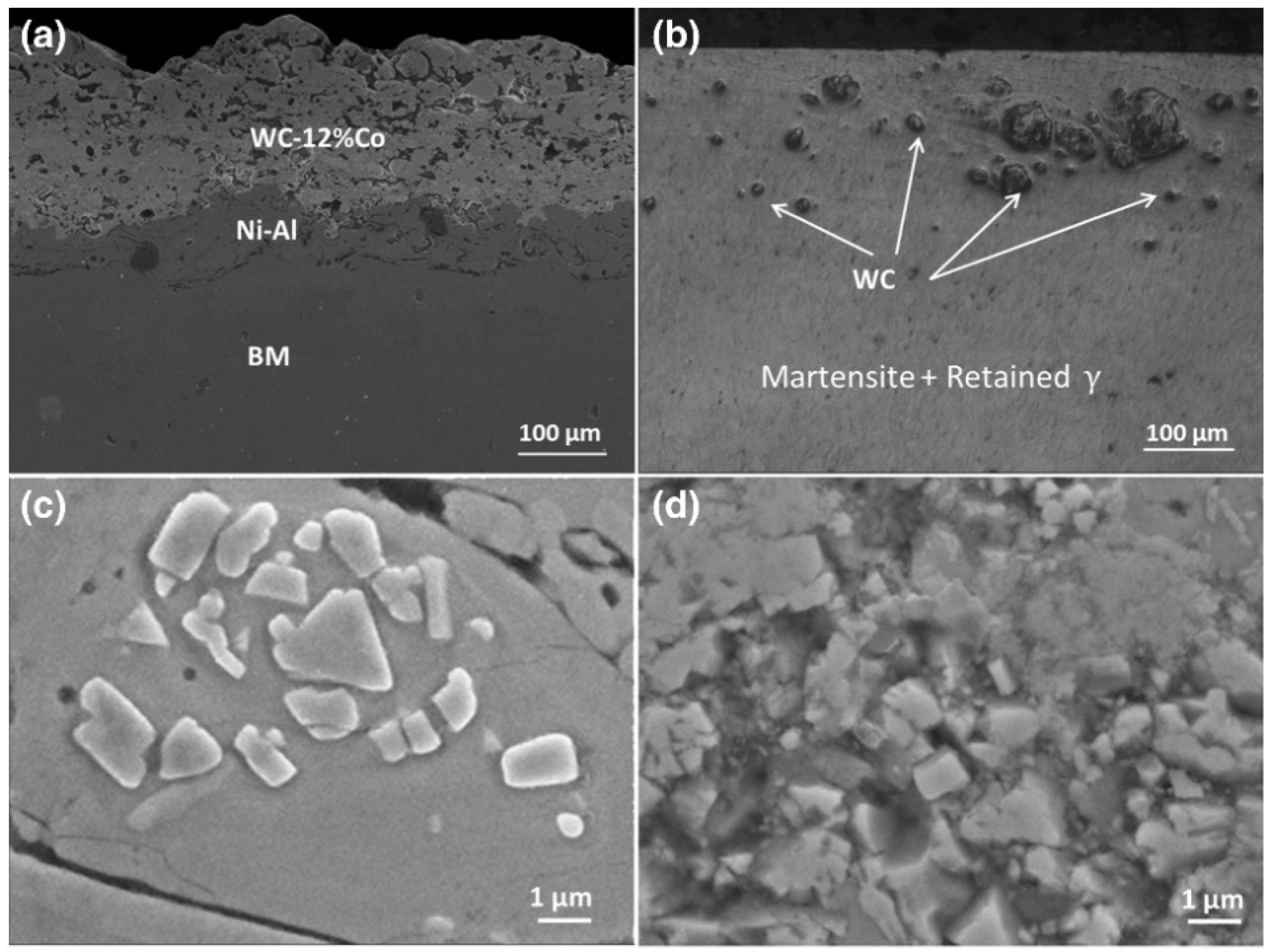
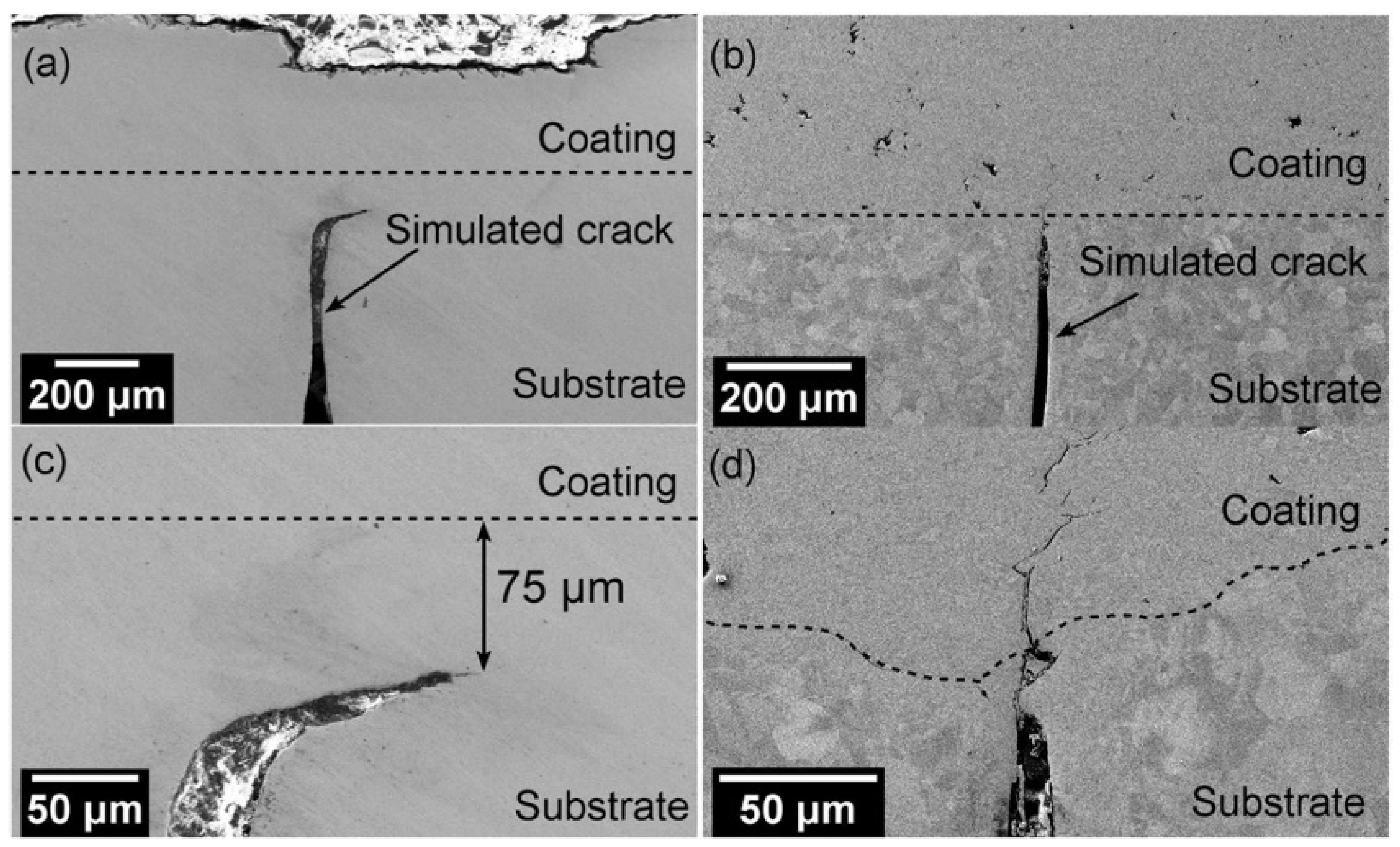
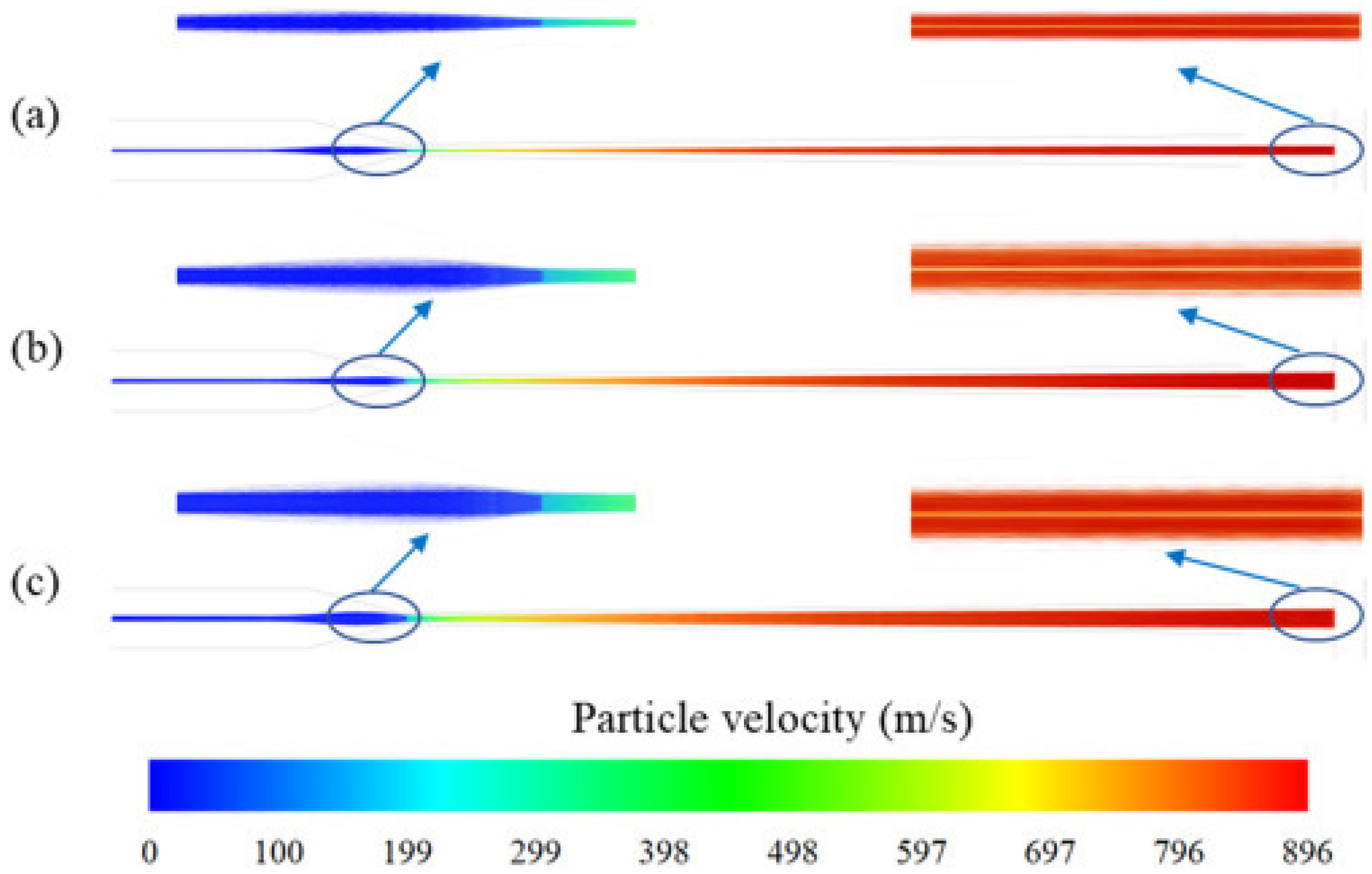

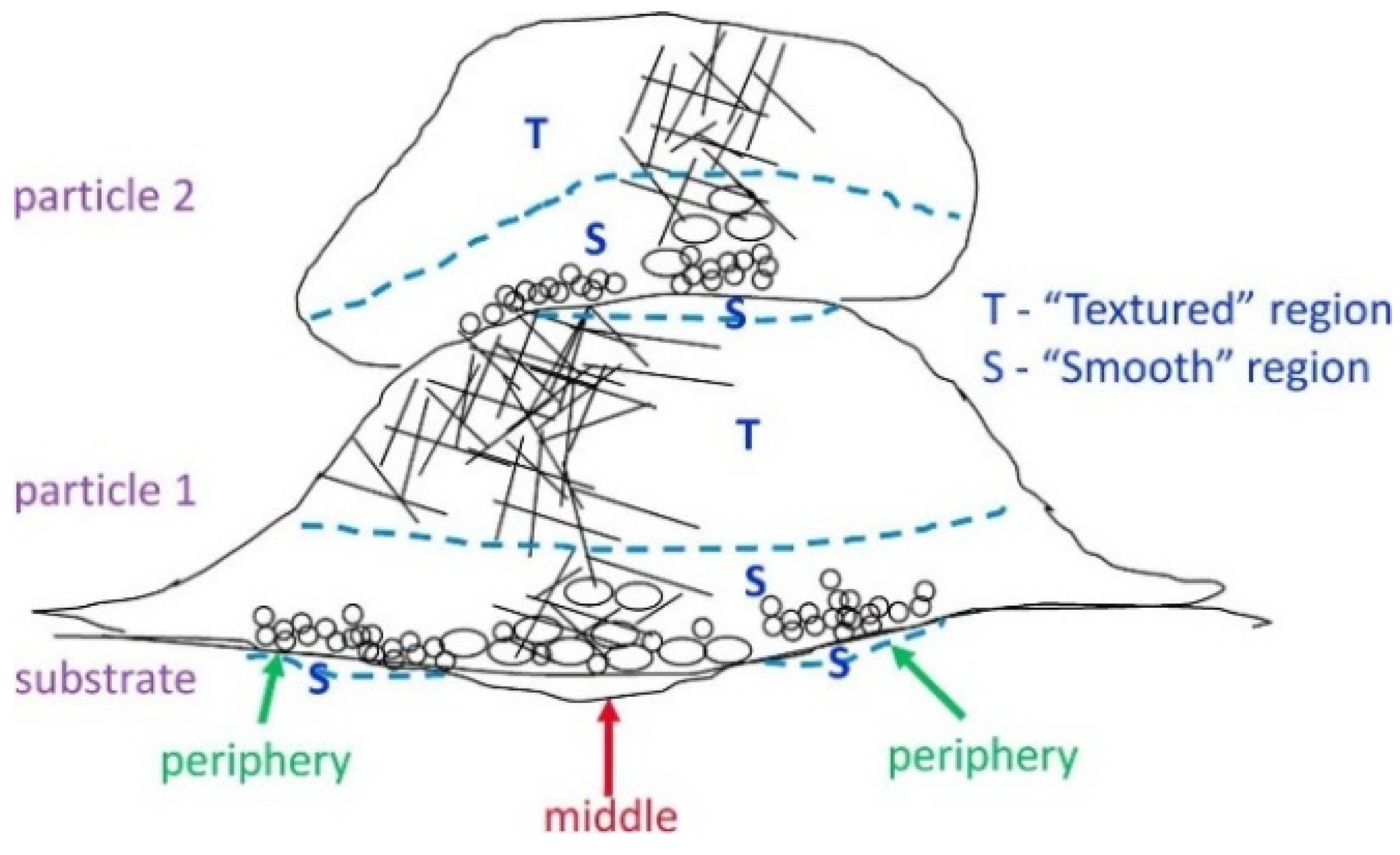







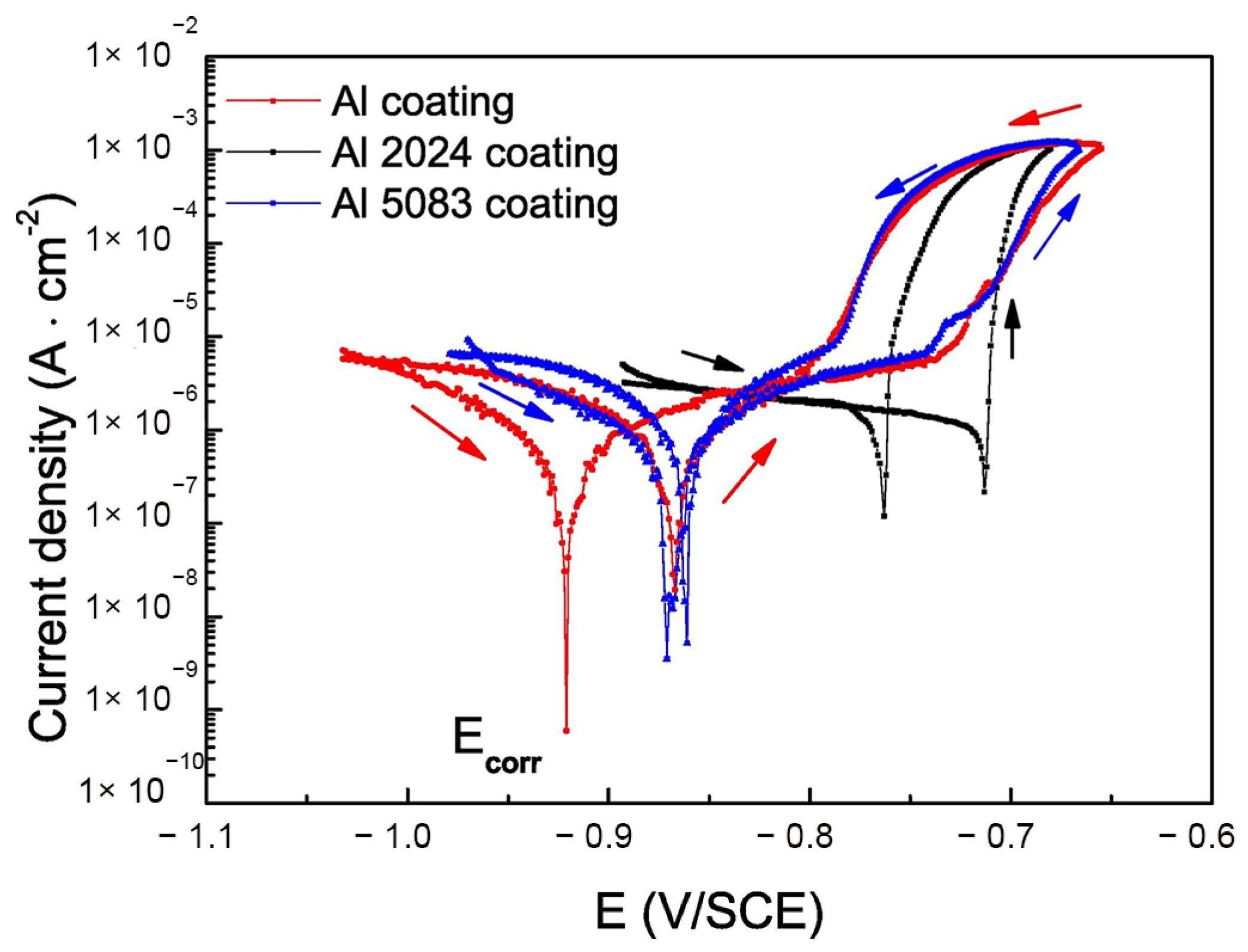


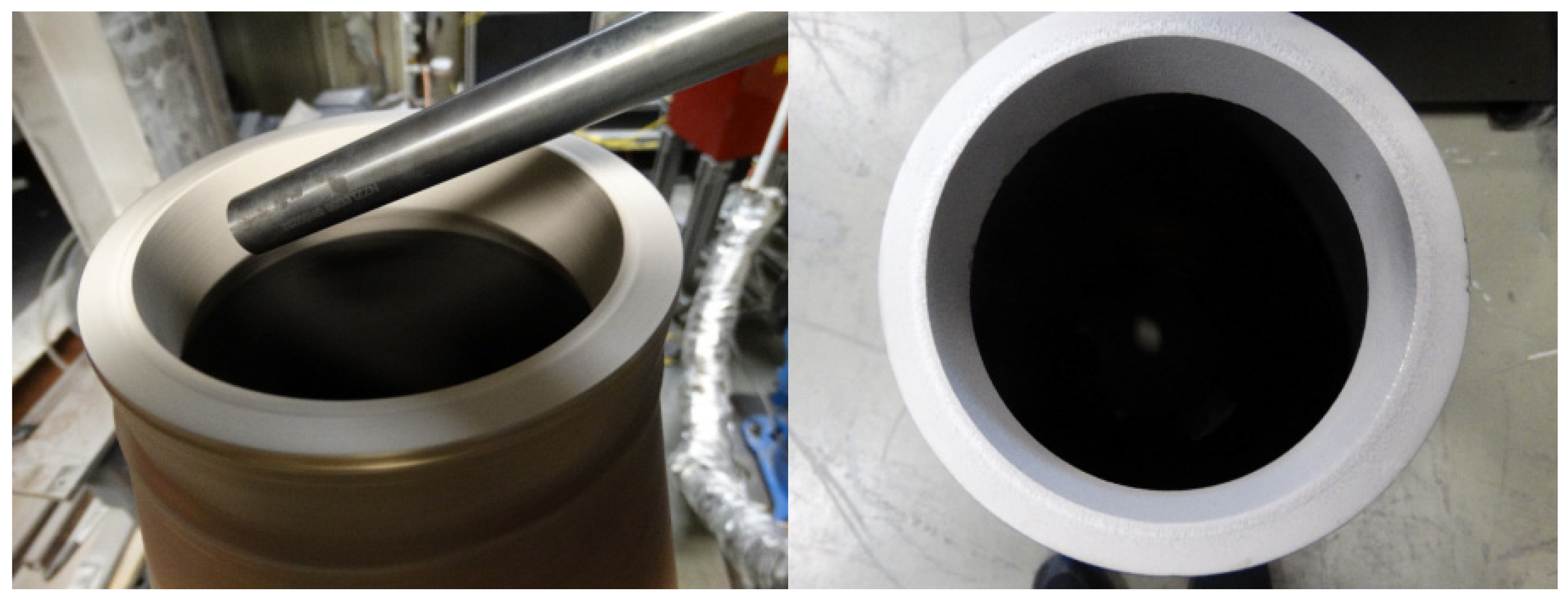

| Name | C Max(%) | Si Max (%) | Mn Max (%) | P Max (%) | S Max (%) | Cr Max (%) | Ni Max (%) | Mo Max (%) | B Max (%) |
|---|---|---|---|---|---|---|---|---|---|
| Armox 500 T | 0.32 | 0.40 | 1.20 | 0.010 | 0.003 | 1.0 | 1.80 | 0.70 | 0.005 |
| Armox 600 T | 0.47 | 0.70 | 1.0 | 0.010 | 0.003 | 1.5 | 3.0 | 0.70 | 0.005 |
| Armox advance | 0.47 | 0.70 | 1.0 | 0.010 | 0.003 | 1.5 | 3.0 | 0.7 | 0.005 |
| Name | Hardness (BHN) | 0.2% Yield Strength (N/mm2) | Tensile Strength (N/mm2) | Elongation (%) |
|---|---|---|---|---|
| Armox 500 T | 480–540 | min 1250 | 1450–1750 | Min 8 |
| Armox 600 T | 570–640 | 1500 | 2000 | 7 |
| Armox advance | HRC58-63 | 1600 | 2250 | 9 |
| Ni (%) | Hardness (HV0.3) | Porosity (%) | Binder Mean Free Path (µm) | WC Retained (%) | ||||
|---|---|---|---|---|---|---|---|---|
| WC | WC12Co | WC | WC12Co | WC | WC12Co | WC | WC12Co | |
| 4 | 459 ± 19 | 414.9 ± 23.2 | 1.47 | 3.51 | 5.42 | 1.77 | 39.89 | 74.08 |
| 10 | 391.5 ± 16.1 | 362.2 ± 32.6 | 2.27 | 3.15 | 12.54 | 3.10 | 24.47 | 63.54 |
| 25 | 305.6 ± 17.0 | 294.3 ± 31.6 | 2.70 | 3.79 | 21.21 | 4.85 | 17.07 | 47.92 |
| 50 | 275.8 ± 16.3 | 260.9 ± 25.4 | 2.49 | 5.11 | 48.59 | 10.09 | 6.92 | 27.06 |
| Parameter | AA 7075-T6 | WC-12Co | WC-25Co |
| Ei→0 (mV vs. Ag|AgCl|KCl3 mol/L | −814 ± 2 | −326 ± 4 | −425 ± 2 |
| Ecorr (mV vs. Ag|AgCl|KCl3 mol/L | −831 ± 2 | −336 ± 2 | −425 ± 1 |
| aicorr (μA cm−2) | 10.7 | 28 | 30 |
| bicorr (μA cm−2) | 2.9 | 10 | 23 |
| ba (mV dec−1) | 82.5 | 148 | 111 |
Disclaimer/Publisher’s Note: The statements, opinions and data contained in all publications are solely those of the individual author(s) and contributor(s) and not of MDPI and/or the editor(s). MDPI and/or the editor(s) disclaim responsibility for any injury to people or property resulting from any ideas, methods, instructions or products referred to in the content. |
© 2023 by the authors. Licensee MDPI, Basel, Switzerland. This article is an open access article distributed under the terms and conditions of the Creative Commons Attribution (CC BY) license (https://creativecommons.org/licenses/by/4.0/).
Share and Cite
Lupu, F.C.; Munteanu, C.; Sachelarie, A.C.; Arsenoaia, V.N.; Istrate, B. Improving the Usage Properties of Steel Using Cold Spray Deposition: A Review. Crystals 2023, 13, 245. https://doi.org/10.3390/cryst13020245
Lupu FC, Munteanu C, Sachelarie AC, Arsenoaia VN, Istrate B. Improving the Usage Properties of Steel Using Cold Spray Deposition: A Review. Crystals. 2023; 13(2):245. https://doi.org/10.3390/cryst13020245
Chicago/Turabian StyleLupu, Fabian Cezar, Corneliu Munteanu, Adrian Constantin Sachelarie, Vlad Nicolae Arsenoaia, and Bogdan Istrate. 2023. "Improving the Usage Properties of Steel Using Cold Spray Deposition: A Review" Crystals 13, no. 2: 245. https://doi.org/10.3390/cryst13020245
APA StyleLupu, F. C., Munteanu, C., Sachelarie, A. C., Arsenoaia, V. N., & Istrate, B. (2023). Improving the Usage Properties of Steel Using Cold Spray Deposition: A Review. Crystals, 13(2), 245. https://doi.org/10.3390/cryst13020245








